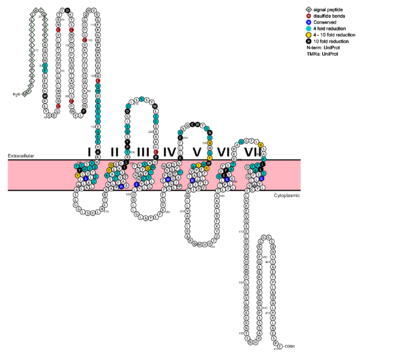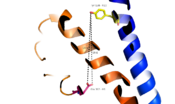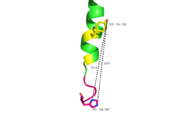Sandbox Reserved 1180
From Proteopedia
(Difference between revisions)
| Line 1: | Line 1: | ||
| - | ==4L6R== | ||
<StructureSection load='4L6R' size='340' side='right' caption='7TM structure of human class B GPCR 4L6R', [[Resolution|resolution]] 1.80Å' scene=''> | <StructureSection load='4L6R' size='340' side='right' caption='7TM structure of human class B GPCR 4L6R', [[Resolution|resolution]] 1.80Å' scene=''> | ||
G protein coupled receptors (GPCRs) are recognized as the largest known class of integral membrane proteins and are divided into five families; the rhodopsin family (class A), the secretin family (class B), the adhesion family, the glutamate family (class C), and the frizzled/taste family (class F). Roughly 5% of the human genome encodes g-protein-coupled receptors which are responsible for the transduction of endogenous signals and the instigation of cellular response. The variants all contain a similar seven α-helical transmembrane domain (TMD or 7TMD) that, once bound to its peptide ligand, undergoes conformational change and tranduces a signal to coupled, heterotrimeric G proteins which initiate intracellular signal pathways and generate physiological and pathological processes. <ref>DOI 10.1371/journal.pcbi.0020013</ref> | G protein coupled receptors (GPCRs) are recognized as the largest known class of integral membrane proteins and are divided into five families; the rhodopsin family (class A), the secretin family (class B), the adhesion family, the glutamate family (class C), and the frizzled/taste family (class F). Roughly 5% of the human genome encodes g-protein-coupled receptors which are responsible for the transduction of endogenous signals and the instigation of cellular response. The variants all contain a similar seven α-helical transmembrane domain (TMD or 7TMD) that, once bound to its peptide ligand, undergoes conformational change and tranduces a signal to coupled, heterotrimeric G proteins which initiate intracellular signal pathways and generate physiological and pathological processes. <ref>DOI 10.1371/journal.pcbi.0020013</ref> | ||
| Line 7: | Line 6: | ||
The glucagon class B GPCR (GCGR) is involved in glucose homeostasis through the binding of the signal peptide glucagon. | The glucagon class B GPCR (GCGR) is involved in glucose homeostasis through the binding of the signal peptide glucagon. | ||
| - | == | + | ==Glucagon Receptor== |
Glucagon is released from pancreatic α-cells when blood glucose levels fall after a period of fasting or several hours following intake of dietary carbohydrates. Once the peptide hormone is released, it binds to GCGR which is a 485 amino acid protein found in the liver, kidney, intestinal smooth muscle, brain, and adipose tissues. <ref name= "Yang 2015">DOI 10.1038/aps.2015.78</ref> Upon binding, signaling is initiated to heterotrimeric G-proteins containing Gαs. <ref name= "Ahren 2009">DOI 10.1038/nrd2782</ref> Additionally, GCGR can regulate additional signal pathways including G-proteins of the Gαi family through the adoption of differing receptor conformations. <ref name= "Xu 2009">DOI 10.3109/10799890903295150</ref> | Glucagon is released from pancreatic α-cells when blood glucose levels fall after a period of fasting or several hours following intake of dietary carbohydrates. Once the peptide hormone is released, it binds to GCGR which is a 485 amino acid protein found in the liver, kidney, intestinal smooth muscle, brain, and adipose tissues. <ref name= "Yang 2015">DOI 10.1038/aps.2015.78</ref> Upon binding, signaling is initiated to heterotrimeric G-proteins containing Gαs. <ref name= "Ahren 2009">DOI 10.1038/nrd2782</ref> Additionally, GCGR can regulate additional signal pathways including G-proteins of the Gαi family through the adoption of differing receptor conformations. <ref name= "Xu 2009">DOI 10.3109/10799890903295150</ref> | ||
==Structural Considerations== | ==Structural Considerations== | ||
===Comparison between Class A and Class B GPCRs=== | ===Comparison between Class A and Class B GPCRs=== | ||
| - | The class B GPCRs, of which GCGR is a member, are different from other Class A GPCRs in several ways. The first is that class B GPCRs contain a protrusion known as a 'stalk,' which is a three α-helical turn elongation of the N-terminus that protrudes past the extracellular (EC) membrane. Structural integrity of this domain in GCGR is essential to ligand binding affinity. (Fig's 1 and 2) | + | The class B GPCRs, of which GCGR is a member, are different from other Class A GPCRs in several ways. The first is that class B GPCRs contain a protrusion known as a 'stalk,' which is a three α-helical turn elongation of the N-terminus that protrudes past the extracellular (EC) membrane. Structural integrity of this domain in GCGR is essential to ligand binding affinity. (Fig's 1 and 2) |
| - | Secondly, the extracellular loop 1 (ECL1) is 3-4 times longer than comparable loops in class A GPCRs, and also affects ligand binding affinity. (Fig. 3)<ref name= "Siu 2013"/> | + | Secondly, the extracellular loop 1 (ECL1) is 3-4 times longer than comparable loops in class A GPCRs, and also affects ligand binding affinity. (Fig. 3)<ref name= "Siu 2013"/> |
Most notably, class B GPCRs contain a prominent central splay (Fig. 4) <scene name='72/727091/Corticotropin_glucagon_aligned/1'>(two Class B protein receptors demonstrating central splay)</scene> which is solvent filled and accessible from the extracellular side. This central splay is notably absent from class A GPCRs (Fig. 5) <scene name='72/727091/B2-adrenergic_glucagon_aligned/9'>(Class A vs. Class B GPCRs)</scene>, represents a tantalizing target for agonists/antagonists, and is the focus of much current research into GCGR signal regulation. <ref name= "Hollenstein 2014"/> | Most notably, class B GPCRs contain a prominent central splay (Fig. 4) <scene name='72/727091/Corticotropin_glucagon_aligned/1'>(two Class B protein receptors demonstrating central splay)</scene> which is solvent filled and accessible from the extracellular side. This central splay is notably absent from class A GPCRs (Fig. 5) <scene name='72/727091/B2-adrenergic_glucagon_aligned/9'>(Class A vs. Class B GPCRs)</scene>, represents a tantalizing target for agonists/antagonists, and is the focus of much current research into GCGR signal regulation. <ref name= "Hollenstein 2014"/> | ||
| - | |||
| - | [[Image:Corticotropin class B and Glucagon class B receptors aligned.png |150 px|left|thumb|Fig. 4: Corticotropin-releasing factor 1 and glucagon receptors; Class B GPCRs with notable central splay]] [[Image:Beta2 class A and Glucagon class B receptors aligned.png |150 px|right|thumb|Fig. 5: Beta 2-adrenergic (class A) and glucagon receptors; showing an absence of central splay in Class A GPCRs.]] | ||
===Structurally Significant GCGR 7TDM Residues=== | ===Structurally Significant GCGR 7TDM Residues=== | ||
| Line 27: | Line 24: | ||
==Functions of Glucagon receptor (GCGR)== | ==Functions of Glucagon receptor (GCGR)== | ||
| - | + | It has been discovered that the large, soluble N-terminal extracellular domains (ECD) of GCGR are primary in ligand selectivity with the deep, ligand pocket (Fig. 7) of the TMD providing secondary recognition. <ref name= "Yang 2015"/> | |
| - | It has been discovered that the large, soluble N-terminal extracellular domains (ECD) of GCGR are primary in ligand selectivity with the deep, ligand pocket (Fig. 7) of the TMD providing secondary recognition. <ref name= "Yang 2015"/> | + | |
| - | ===Conformational changes=== | ||
Because of the difficulty of stabilizing and crystallizing Class B TMDs, very little is known about the conformational changes that transduce cell signals endogenously. It is known that GCGR can regulate additional signal pathways including G-proteins of the Gαi family through the adoption of differing receptor conformations. Research is ongoing. <ref name= "Xu 2009"/> | Because of the difficulty of stabilizing and crystallizing Class B TMDs, very little is known about the conformational changes that transduce cell signals endogenously. It is known that GCGR can regulate additional signal pathways including G-proteins of the Gαi family through the adoption of differing receptor conformations. Research is ongoing. <ref name= "Xu 2009"/> | ||
| - | ===Signaling pathways=== | ||
GCGR generates downstream signals predominantly through the increase of intracellular cAMP, however there are other pathways being uncovered that are the result of GCGR adopting multiple, active conformations. Researchers are currently investigating how receptor activity-modifying proteins (RAMPs) interact with the ligand and GCGR in which the signaling bias of the receptor is altered. <ref>DOI 10.1074/jbc.M114.624601</ref> | GCGR generates downstream signals predominantly through the increase of intracellular cAMP, however there are other pathways being uncovered that are the result of GCGR adopting multiple, active conformations. Researchers are currently investigating how receptor activity-modifying proteins (RAMPs) interact with the ligand and GCGR in which the signaling bias of the receptor is altered. <ref>DOI 10.1074/jbc.M114.624601</ref> | ||
| - | + | ||
| - | + | ||
GPCR activity is regularly quantified by ligand binding affinity, potency, efficacy, and kinetics. These measurement are used to measure drug ligand interactions in vivo. Recently, GPCRs have been crystallized and catalogued, which tend to include a need to stabilize the receptor, emphasizing the instability of the G coupled protein receptor. Zhang et. al. imply the importance of receptor folding in the cell membrane, in the human class B GPCR the 7TM portion, for receptor stability and function. <ref>DOI 10.1016/j.tibs.2014.12.005</ref> | GPCR activity is regularly quantified by ligand binding affinity, potency, efficacy, and kinetics. These measurement are used to measure drug ligand interactions in vivo. Recently, GPCRs have been crystallized and catalogued, which tend to include a need to stabilize the receptor, emphasizing the instability of the G coupled protein receptor. Zhang et. al. imply the importance of receptor folding in the cell membrane, in the human class B GPCR the 7TM portion, for receptor stability and function. <ref>DOI 10.1016/j.tibs.2014.12.005</ref> | ||
==The Signal Peptide: Glucagon== | ==The Signal Peptide: Glucagon== | ||
| - | + | ||
| - | + | ||
Glucagon, a signaling ligand in the metabolic pathway, has three main biological functions. | Glucagon, a signaling ligand in the metabolic pathway, has three main biological functions. | ||
| Line 52: | Line 44: | ||
<ref name = 'Lehninger'>'Lehninger A., Nelson D.N, & Cox M.M. (2008) Lehninger Principles of Biochemistry. W. H. Freeman, fifth edition.' </ref> | <ref name = 'Lehninger'>'Lehninger A., Nelson D.N, & Cox M.M. (2008) Lehninger Principles of Biochemistry. W. H. Freeman, fifth edition.' </ref> | ||
| - | |||
| - | ===Glucagon Peptide Stability and Active Binding Sites=== | ||
Essential, conserved residues of glucagon, as discovered through mutagenesis and photo cross-linking studies have been labeled and colored in red. <ref name= "Siu 2013"/> <scene name='72/727091/Glucagon_important_residues/2'>Important stability/active sites</scene> | Essential, conserved residues of glucagon, as discovered through mutagenesis and photo cross-linking studies have been labeled and colored in red. <ref name= "Siu 2013"/> <scene name='72/727091/Glucagon_important_residues/2'>Important stability/active sites</scene> | ||
| - | ===Active binding domains/sites=== | ||
Through mutagenesis and photo-crosslinking studies, several residues deep within the central cavity of the GCGR 7TMD were discovered neighboring Glu362, which is approximately 19 angstroms from the base of the EC stalk and the location of Tyr138. (Fig. 8) | Through mutagenesis and photo-crosslinking studies, several residues deep within the central cavity of the GCGR 7TMD were discovered neighboring Glu362, which is approximately 19 angstroms from the base of the EC stalk and the location of Tyr138. (Fig. 8) | ||
[[Image:Movie Frame 8.png |150 px|left|thumb|Fig.8: Relationship between Tyr138 and Glu362 - residues found to have direct relationship to glucagon binding affinity.]] | [[Image:Movie Frame 8.png |150 px|left|thumb|Fig.8: Relationship between Tyr138 and Glu362 - residues found to have direct relationship to glucagon binding affinity.]] | ||
Four essential residues exist deep within the central cavity which all play strong roles in ligand binding affinity. (Fig. 9) | Four essential residues exist deep within the central cavity which all play strong roles in ligand binding affinity. (Fig. 9) | ||
| - | [[Image:Movie Frame 3.png |200 px|right|thumb|Fig. 9: Location of anchoring pocket within central cavity.<ref name= "Siu 2013"/>]] | ||
A narrow entry gives way to a large, anchoring site for residues 1-4 of glucagon. (Fig. 10) | A narrow entry gives way to a large, anchoring site for residues 1-4 of glucagon. (Fig. 10) | ||
| - | [[Image:Movie Frame 6.png |100 px|left|thumb|Fig. 10: Ballooned pocket functioning as anchoring site for glucagon residues 1-4.]] | ||
Essential to glucagon's binding, a long, N-terminal tail winds to a clump of 4 residues, culminating in bulge that fits into the central, anchoring site of the 7TMD. (Fig. 11) | Essential to glucagon's binding, a long, N-terminal tail winds to a clump of 4 residues, culminating in bulge that fits into the central, anchoring site of the 7TMD. (Fig. 11) | ||
Revision as of 17:54, 20 April 2016
| |||||||||||
References
- ↑ Zhang Y, Devries ME, Skolnick J. Structure modeling of all identified G protein-coupled receptors in the human genome. PLoS Comput Biol. 2006 Feb;2(2):e13. Epub 2006 Feb 17. PMID:16485037 doi:http://dx.doi.org/10.1371/journal.pcbi.0020013
- ↑ Bortolato A, Dore AS, Hollenstein K, Tehan BG, Mason JS, Marshall FH. Structure of Class B GPCRs: new horizons for drug discovery. Br J Pharmacol. 2014 Jul;171(13):3132-45. doi: 10.1111/bph.12689. PMID:24628305 doi:http://dx.doi.org/10.1111/bph.12689
- ↑ 3.0 3.1 Hollenstein K, de Graaf C, Bortolato A, Wang MW, Marshall FH, Stevens RC. Insights into the structure of class B GPCRs. Trends Pharmacol Sci. 2014 Jan;35(1):12-22. doi: 10.1016/j.tips.2013.11.001. Epub, 2013 Dec 18. PMID:24359917 doi:http://dx.doi.org/10.1016/j.tips.2013.11.001
- ↑ Hollenstein K, Kean J, Bortolato A, Cheng RK, Dore AS, Jazayeri A, Cooke RM, Weir M, Marshall FH. Structure of class B GPCR corticotropin-releasing factor receptor 1. Nature. 2013 Jul 25;499(7459):438-43. doi: 10.1038/nature12357. Epub 2013 Jul 17. PMID:23863939 doi:http://dx.doi.org/10.1038/nature12357
- ↑ 5.0 5.1 5.2 5.3 Siu FY, He M, de Graaf C, Han GW, Yang D, Zhang Z, Zhou C, Xu Q, Wacker D, Joseph JS, Liu W, Lau J, Cherezov V, Katritch V, Wang MW, Stevens RC. Structure of the human glucagon class B G-protein-coupled receptor. Nature. 2013 Jul 25;499(7459):444-9. doi: 10.1038/nature12393. Epub 2013 Jul 17. PMID:23863937 doi:10.1038/nature12393
- ↑ 6.0 6.1 6.2 6.3 6.4 Yang DH, Zhou CH, Liu Q, Wang MW. Landmark studies on the glucagon subfamily of GPCRs: from small molecule modulators to a crystal structure. Acta Pharmacol Sin. 2015 Sep;36(9):1033-42. doi: 10.1038/aps.2015.78. Epub 2015, Aug 17. PMID:26279155 doi:http://dx.doi.org/10.1038/aps.2015.78
- ↑ Ahren B. Islet G protein-coupled receptors as potential targets for treatment of type 2 diabetes. Nat Rev Drug Discov. 2009 May;8(5):369-85. doi: 10.1038/nrd2782. Epub 2009 Apr, 14. PMID:19365392 doi:http://dx.doi.org/10.1038/nrd2782
- ↑ 8.0 8.1 Xu Y, Xie X. Glucagon receptor mediates calcium signaling by coupling to G alpha q/11 and G alpha i/o in HEK293 cells. J Recept Signal Transduct Res. 2009 Dec;29(6):318-25. doi:, 10.3109/10799890903295150. PMID:19903011 doi:http://dx.doi.org/10.3109/10799890903295150
- ↑ Weston C, Lu J, Li N, Barkan K, Richards GO, Roberts DJ, Skerry TM, Poyner D, Pardamwar M, Reynolds CA, Dowell SJ, Willars GB, Ladds G. Modulation of Glucagon Receptor Pharmacology by Receptor Activity-modifying Protein-2 (RAMP2). J Biol Chem. 2015 Sep 18;290(38):23009-22. doi: 10.1074/jbc.M114.624601. Epub, 2015 Jul 21. PMID:26198634 doi:http://dx.doi.org/10.1074/jbc.M114.624601
- ↑ Zhang X, Stevens RC, Xu F. The importance of ligands for G protein-coupled receptor stability. Trends Biochem Sci. 2015 Feb;40(2):79-87. doi: 10.1016/j.tibs.2014.12.005. Epub, 2015 Jan 15. PMID:25601764 doi:http://dx.doi.org/10.1016/j.tibs.2014.12.005
- ↑ 'Lehninger A., Nelson D.N, & Cox M.M. (2008) Lehninger Principles of Biochemistry. W. H. Freeman, fifth edition.'
- ↑ 12.0 12.1 Salon JA, Lodowski DT, Palczewski K. The significance of G protein-coupled receptor crystallography for drug discovery. Pharmacol Rev. 2011 Dec;63(4):901-37. doi: 10.1124/pr.110.003350. PMID:21969326 doi:http://dx.doi.org/10.1124/pr.110.003350







